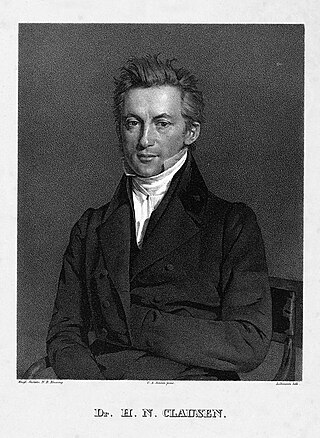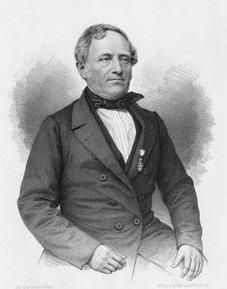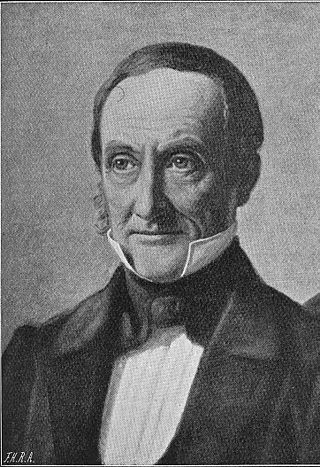
The German Confederation was an association of 39 predominantly German-speaking sovereign states in Central Europe. It was created by the Congress of Vienna in 1815 as a replacement of the former Holy Roman Empire, which had been dissolved in 1806 in reaction to the Napoleonic Wars.

Johan Peter Emilius Hartmann was, together with his son-in-law Niels W. Gade, the leading Danish composer of the 19th century, a period known as the Danish Golden Age. According to Alfred Einstein, he was "the real founder of the Romantic movement in Denmark and even in all Scandinavia". J.P.E. Hartmann was the third generation of composers in the Danish musical Hartmann family.

Joakim Frederik Schouw was a Danish lawyer, botanist and politician. From 1821, professor in botany at the University of Copenhagen — first extraordinary professor, but after the death of J.W. Hornemann in 1841 ordinary. His main scientific field was the new discipline of phytogeography. He also served as director of Copenhagen Botanical Garden in 1841-1852. He was a leading figure in the National Liberal movement and president of the Danish Constituent Assembly in 1848.
The Society of the Friends of Peasants was a liberal Danish political society founded on 5 May 1846 by members of the provincial consultative assemblies Johan Christian Drewsen and Balthazar Christensen, with the intent to promote the liberation of the peasantry and equality among the different classes of society. Among its most politically influential members were Anton Frederik Tscherning, Jens Andersen Hansen and Carl Christian Alberti.

Henrik Nicolai Clausen was a Danish theologian and national liberal politician. He was a member of the National Constitutional Assembly from 1848 to 1849, of the Folketing from 1849 to 1853 and of the Landsting from 1853 to 1863.
Cuthbert William Johnson was an English barrister and agricultural writer.

Caspar Peder Rothe Ingerslev was a Danish politician, procurator and landowner. He served at different times in the Folketing, Landstinget, Danish supreme court and on the advisory council to the king. He married into the wealthy Meulengracht family and fathered the future minister Hans Peter Ingerslev. Ingerslev was also active in local politics and managed the Marselisborg Manor for many years.

Johan Christian Drewsen was a Danish paper manufacturer, agronomist and politician. He owned Strandmøllen north of Copenhagen.

Martin Johannes Hammerich was a Danish art historian, educator, author, and translator. He was part of the National Liberal movement and a member of the 1848 Danish Constituent Assembly. He was headmaster of Borgerdydskolerne from 1842 to 1867.

The Danish Constituent Assembly is the name given to the 1848 Constitutional assembly at Christiansborg Palace in Copenhagen that approved the Danish Constitution and formalized the transition from absolute monarchy to constitutional democracy. It consisted of members of which 114 were elected by the people, 38 were appointed by the king and the rest were government ministers.

Carl (de) Neergaard was a Danish landowner and politician. He was the owner of Gunderslevholm and Kastrup on central Zealand. He was a member of the 1848 Danish Constituent Assembly.

Carl Emil Mundt was a Danish educator and politician. He was a member of the 1848 Danish Constituent Assembly, representing Sorø. He was the father of painter Emilie Mundt.
Henrik Larsen Kyhl was a Danish clockmaker, politician and the second managing director of Tivoli Gardens in Copenhagen.

Benjamin Wolff was a Danish businessman, landowner and art collector. After twelve years in India (1817–1829) working for the English trade agency Cruttenden, Mackillop & Co., Wolff returned to Denmark as a wealthy man and acquired Engelholm Manor south of Copenhagen.

Balthazar Matthias Christensen was a Danish jurist and politician representing the Society of the Friends of Peasants.

Nicolai Elias Tuxen was a Danish naval officer and politician, technical director of Orlogsværftet in Copenhagen. He was a member of the Danish Constituent Assembly. He was the father of painter Laurits Tuxen.

Nicolai Jonathan Meinert was a Danish businessman and politician. He was the father of astronomer Frederik Vilhelm August Meinert.

Christian Frederik Zeuthen was a Danish landowner and diplomat. In 1843, he was created a baron and his estates Tølløsegård and Sonnerupgaard were at the same time converted into a barony.. He was a member of the Danish Constituent Assembly by royal appointment.

The Trentwedel House is a Baroque style townhouse situated at Stengade 81 in central Helsingør, Denmark. It overlooks a small triangular plaza on the harbour front (Havnegade). The building was listed in the Danish registry of protected buildings and places in 1919.
















